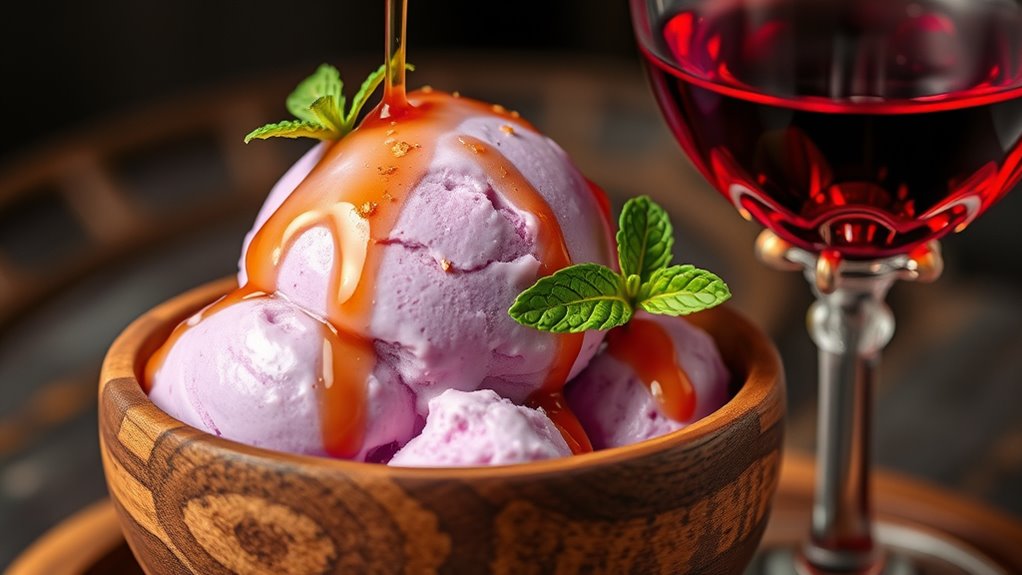Pairing gelato with dessert wines elevates your dessert experience by enhancing flavors and adding richness. When you match the wine’s sweetness and acidity with your gelato’s profile, you create a harmonious balance that highlights each element. Options like Port, Moscato d’Asti, or ice wine complement different gelato flavors beautifully. If you want to discover how specific pairings can transform your treats, exploring further will reveal even more delightful combinations.
Key Takeaways
- Pair dessert wines with gelato based on matching sweetness levels to enhance flavors without overwhelming them.
- Use wines’ acidity to complement and highlight different gelato flavor profiles, such as fruit or nutty varieties.
- Port pairs well with rich, creamy gelato, while lighter wines like Moscato d’Asti suit delicate, fruit-based flavors.
- Affordable dessert wines are widely available and suitable for everyday indulgence, enhancing gelato without high costs.
- Proper pairing creates a sophisticated tasting experience, elevating simple gelato into an elegant, memorable dessert.

Ever wondered how to elevate your gelato experience? The secret lies in pairing it with the right dessert wines. These sweet wines, like Port, Moscato d’Asti, ice wine, and others, can transform a simple scoop into a sophisticated dessert.
Discover how pairing gelato with dessert wines elevates your sweet indulgence to a refined experience.
When you choose a dessert wine that complements your gelato’s flavor and texture, you discover a new level of richness and balance. The key is to match the wine’s sweetness to the gelato’s sweetness, which prevents the pairing from becoming too sour or flat, ensuring each bite remains harmonious and vibrant.
Dessert wines are ideal partners because their inherent sweetness and acidity highlight the gelato’s flavors while adding their own complexity. For example, a rich, creamy gelato paired with a Port accentuates its depth, while a light Moscato d’Asti can beautifully enhance fruit-based gelato like roasted strawberry or peach.
Ice wines, with their concentrated sweetness, pair well with more delicate, subtly flavored gelatos, creating a delightful contrast that emphasizes both the wine’s and the gelato’s unique qualities.
Many of these dessert wines are surprisingly affordable, often costing less than $25, making them accessible for everyday indulgence. You can even store them in the fridge for several weeks, allowing you to experiment with different pairings anytime you crave a refined treat.
When selecting a wine, consider its level of sweetness and acidity to match the specific gelato flavor. For example, the bright, bubbly Moscato d’Asti’s slight acidity and sweet, fruity profile make it ideal for complementing citrus or tropical flavors. Meanwhile, a richer Madeira can stand up to more nutty flavors like hazelnut or caramel.
Pairing gelato with dessert wines also allows you to highlight particular flavor combinations. For instance, a roasted strawberry gelato can be elevated by the slight effervescence and fruitiness of Lambrusco, while a hazelnut gelato finds a perfect partner in the nutty, caramel notes of Madeira.
This approach not only enhances the flavor of your gelato but also creates a more memorable tasting experience. Ultimately, the right pairing amplifies the richness of the gelato and the complexity of the wine, turning a simple dessert into an elegant treat that delights your senses and reveals your dessert game.
Frequently Asked Questions
What Wine Goes Well With Gelato?
When choosing a wine to pair with gelato, you want one that complements its sweetness without overpowering it. Look for wines with high residual sugar, like Moscato d’Asti or Lambrusco, which match the dessert’s flavor.
Sparkling options add an invigorating contrast, and wines with bright acidity, such as Riesling or Sauternes, help balance richness. Make sure the wine’s sweetness level is equal to or greater than the gelato’s for the best pairing.
What Wines Are Considered Dessert Wines?
Imagine a glass of rich, amber liquid, a sweet symphony in your hand. You might consider Sauternes, Tokaji, Port, Sherry, or Ice Wines—all classified as dessert wines.
These wines, made from grapes with high residual sugar, come through methods like noble rot or freezing. They’re perfect for pairing with desserts or cheese, offering a luxurious sweetness that elevates any special moment.
What Is the Dessert Wine Rule?
The dessert wine rule says that the wine you serve with a dessert should be at least as sweet as the dessert itself. This way, the wine complements the sweetness instead of overpowering or tasting flat.
If you pick a less sweet wine, it can make the dessert taste bitter or unbalanced. Following this rule guarantees a harmonious pairing that enhances both the wine and the sweet treat.
Is Gewurztraminer a Dessert Wine?
When it comes to whether Gewürztraminer is a dessert wine, the answer isn’t cut and dry. You might think it’s a dessert wine based on its sweet, aromatic styles, especially late-harvest or botrytized versions.
However, most are enjoyed as flavorful dry or semi-sweet wines, like a jack-of-all-trades. So, it’s not strictly a dessert wine, but certain styles certainly lean that way when the grapes are late-harvested or affected by noble rot.
Conclusion
As you savor gelato paired with dessert wines, you paint a picture of sweet harmony dancing on your palate. Each sip and bite gently whispers stories of craftsmanship and tradition, like a soft breeze guiding you through a lush orchard at dusk. Embrace these moments as a delicate brushstroke on your culinary canvas, where every flavor complements and elevates the other. Ultimately, this delightful experience leaves behind a subtle glow, a tender reminder of life’s sweetest pleasures.









